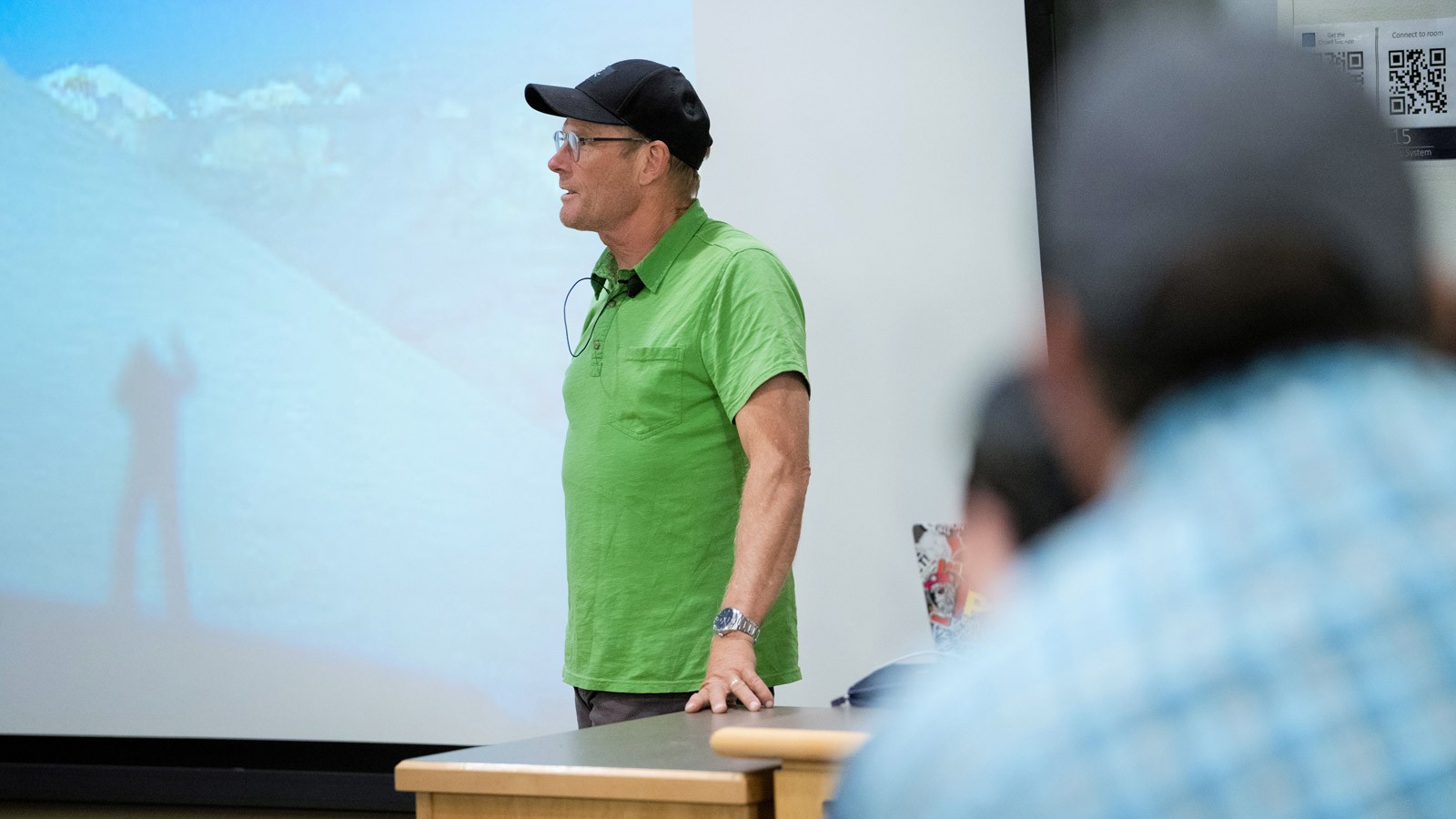Renowned Climber Conrad Anker Talks Mountaineering, Product Design, Climate Change
By Ethan Brightbill |
Conrad Anker speaks to students in Utah State University's Outdoor Product Development & Design on Sept. 2 on the Logan campus. (Photo Credit: USU/Bronson Teichert)
The most dangerous part of climbing Mount Everest, explained climber Conrad Anker during an event at Utah State University, is the Khumbu Icefall. Stemming from the Khumbu Glacier, this river of ice moves over 6 feet a day and is an avalanche-prone maze of deep crevasses. Would-be climbers spend 12 hours traveling just 2½ miles across the constantly shifting icefall on their way to the summit. The path is extremely dangerous, yet many people make the ascent.
Change and the need for people to adapt to it was the theme of Anker’s presentation to students in the USU’s Outdoor Product Design and Development (OPDD) program and members of the public during a visit to the Logan campus Sept. 2. In addition to discussing his three summits of Mount Everest and travels in Antarctica, Patagonia and elsewhere, Anker spoke about how climbing has changed over the decades as well as the impact climate change has had on his industry and the world.
For Anker, climbing is all about adaptability. Unlike in a climbing gym where courses are created by people, scaling a mountain requires improvisation.
“With outdoor climbing,” he said, “you have awkward moves, you have underclings, you have places where you're off balance, and you have to solve them. The more you do, the more your repertoire of moves expands, and the more physical and intellectual experience you have to guide you in choosing a route and how you approach it.”
After 26 years as climbing captain for the outdoor recreation company North Face’s athlete team, Anker also knows firsthand how important the right gear is for a successful climb — and how climbing has been transformed by technology. During his presentation, Anker took the audience back to the very to the first attempts to reach Mount Everest’s summit in the 1920s. At the time, climbers wore welding goggles to protect against sun glare and collared tweed jackets were worn in the absence of waterproof materials like Teflon.
He noted that a climber today can get outfitted with specialized gear with an online order, but at the time of the first Mount Everest ascents, the first zippers had just come onto the market.
It wasn’t until World War II that many of the technologies used in climbing now were developed, and it wasn’t until the 1960s that a boom in outdoor equipment companies made that kind of gear easily available to the public. Since then, additional technologies like the spring-loaded camming device, auto-assist belay device, and stickier rubber have further pushed the boundaries of what climbers can do.
While there are fewer big changes in the industry now, Anker believes there are new concerns that future designers will need to address.
“The outdoor business is pretty mature, so you see smaller changes with things like performance in fabric,” Anker said. “However, now a big part of the ask from the public for a fabric supplier is the sustainability of their process. I spent two weeks in Taiwan touring dye facilities and going through how product is made, and it's chemical- and energy-intensive. The more we're able to recycle the chemicals and energy that go into that, the better.”
Anker showed pictures of places he’d climbed on Mount Everest and elsewhere that had once been covered by snow or glaciers but are now exposed and likely to stay that way. The iconic Everest Base Camp in Nepal from which mountaineers like George Mallory, Edmund Hillary and Anker himself once set out is already in the process of being moved due to the increasing instability of the melting glacier it rests on.
Even so, Anker believes humanity must face the challenge head-on. Like a mountaineer pioneering a new route to the summit, he wants the product designers of tomorrow and the rest of the world to try and adapt.
“We can't let the perfect get in the way of good,” Anker said. “We're not going to be perfect at this, but we have to try.”
Anker’s presentation was followed by a question-and-answer session where he spoke to OPDD students about how to break into high-altitude climbing and the outdoor product design industry and then to the opening of an exhibit at the Merrill-Cazier Library celebrating the history of outdoor recreation and gear.
WRITER
Ethan Brightbill
Writer and Marketing Assistant
College of Veterinary Medicine
Ethan.Brightbill@usu.edu
CONTACT
Chase Anderson
Industry Outreach Coordinator
Outdoor Product Design & Development
385-350-5503
chase.anderson@usu.edu
TOPICS
Environment 263stories Climate 151stories Outdoor 78stories Recreation 69storiesComments and questions regarding this article may be directed to the contact person listed on this page.







